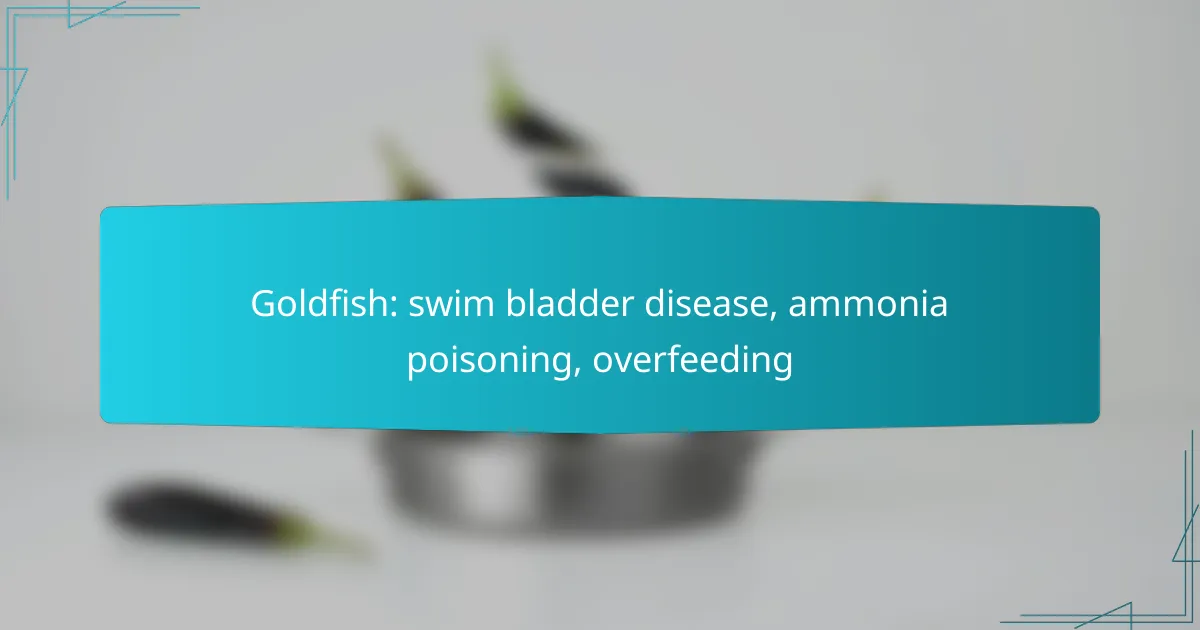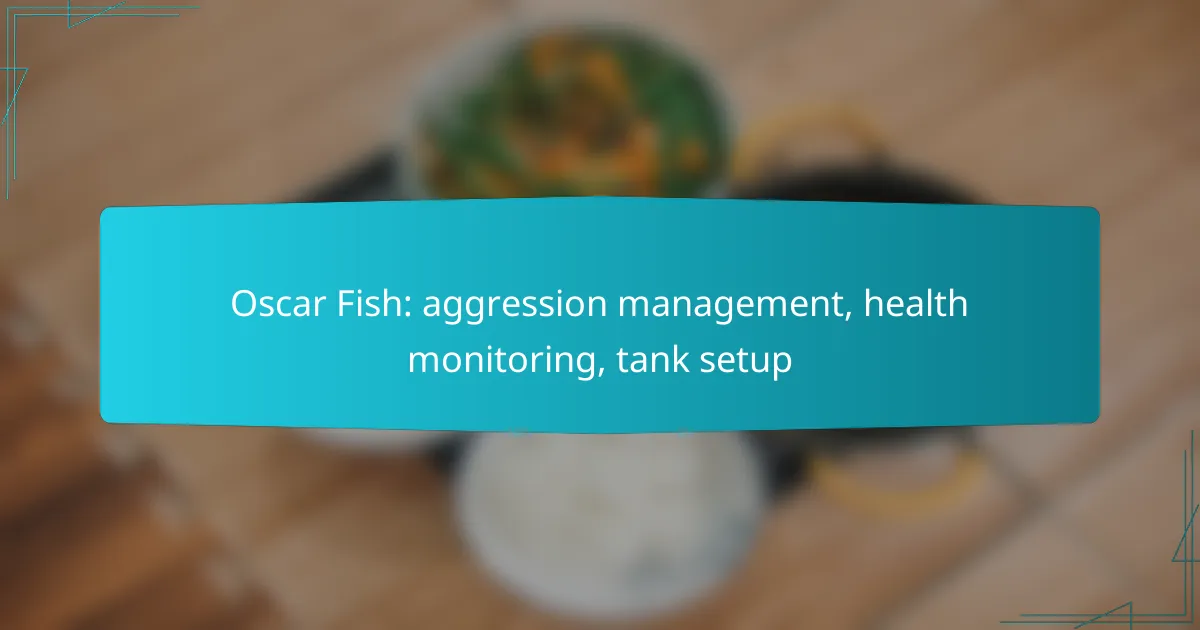Goldfish are popular pets, but they can suffer from various health issues, including swim bladder disease, ammonia poisoning, and the effects of overfeeding. Proper care, including medication, dietary adjustments, and monitoring water quality, is essential for maintaining their health. Recognizing the signs of distress and establishing a consistent feeding routine can help prevent these common problems and ensure a thriving aquarium environment.

How to treat swim bladder disease in goldfish?
Treating swim bladder disease in goldfish involves a combination of medications, dietary adjustments, and improvements in water quality. Addressing these factors can help restore your goldfish’s buoyancy and overall health.
Medications for swim bladder disease
Medications specifically designed for swim bladder disease can help reduce inflammation and improve your goldfish’s condition. Look for products containing antibiotics or anti-inflammatory agents, which can be found at pet stores or online.
Always follow the manufacturer’s instructions regarding dosage and duration of treatment. If symptoms persist after treatment, consult a veterinarian experienced with aquatic animals for further guidance.
Dietary adjustments for swim bladder health
Adjusting your goldfish’s diet is crucial for managing swim bladder disease. Offer high-quality pellets that are specifically formulated for goldfish, as these are easier to digest and less likely to cause bloating.
Incorporating blanched peas or other vegetables can also aid digestion. Avoid overfeeding, as this can exacerbate swim bladder issues; feeding small amounts two to three times a day is generally recommended.
Water quality improvements
Maintaining optimal water quality is essential for preventing and treating swim bladder disease. Regularly test the water for ammonia, nitrite, and nitrate levels, ensuring they remain within safe ranges—ammonia and nitrite should be at 0 ppm, while nitrates should be below 20 ppm.
Perform routine water changes of 10-20% weekly to keep the environment clean. Additionally, ensure proper filtration and aeration to promote a healthy habitat for your goldfish.
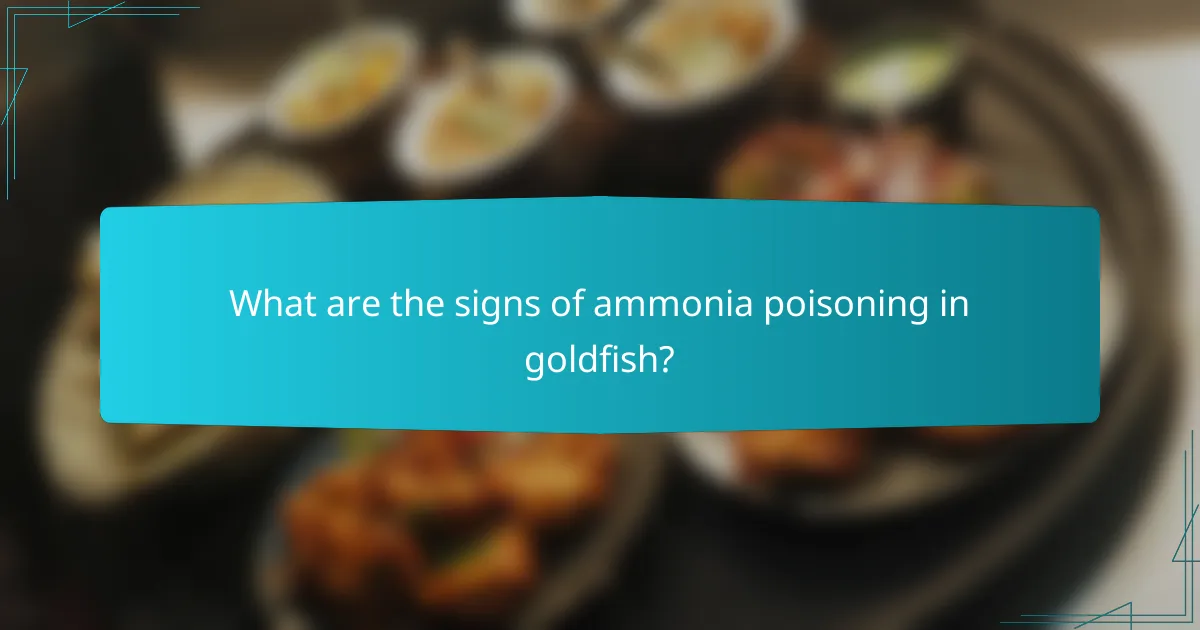
What are the signs of ammonia poisoning in goldfish?
Signs of ammonia poisoning in goldfish include behavioral changes and physical symptoms that indicate stress and toxicity in the water. Monitoring these signs is crucial for maintaining a healthy aquarium environment.
Behavioral changes indicating ammonia poisoning
Goldfish suffering from ammonia poisoning often exhibit noticeable behavioral changes. They may become lethargic, spending more time at the bottom of the tank or hiding among decorations. Additionally, you might observe rapid gill movement and erratic swimming patterns, which signal distress.
Another common behavioral indicator is a lack of appetite. If your goldfish suddenly stops eating or shows disinterest in food, it could be a sign of ammonia toxicity. Regular observation of feeding habits can help catch these changes early.
Physical symptoms of ammonia toxicity
Physical symptoms of ammonia poisoning in goldfish include visible signs of gill irritation and damage. You may notice redness or inflammation around the gills, which can lead to difficulty breathing. This is a critical sign that the water quality needs immediate attention.
Other physical indicators include frayed fins or skin lesions, which can develop due to prolonged exposure to high ammonia levels. Keeping an eye on your goldfish’s appearance can help you identify issues before they escalate into more serious health problems.

How to prevent overfeeding goldfish?
Preventing overfeeding goldfish involves establishing a consistent feeding routine and monitoring portion sizes. By adhering to specific schedules and guidelines, you can maintain your goldfish’s health and avoid issues like swim bladder disease and ammonia poisoning.
Recommended feeding schedules
Goldfish should typically be fed two to three times a day, depending on their age and size. Young goldfish may require more frequent feedings, while adults can thrive on two meals daily. It’s best to feed them at the same times each day to create a routine.
Consider using a timer or setting reminders to ensure you stick to the schedule. This consistency helps regulate their eating habits and reduces the risk of overfeeding.
Portion control guidelines
When feeding goldfish, aim for a portion that they can consume within a few minutes. A common guideline is to offer an amount roughly equivalent to what fits in their mouth, which varies by size. Avoid giving them more food than they can eat in a short time to prevent leftover waste that can lead to ammonia buildup.
As a practical tip, observe your goldfish during feeding. If they consistently leave food uneaten, reduce the portion size. Regularly assess their health and adjust feeding amounts as needed to maintain their well-being.

What are the long-term effects of ammonia poisoning on goldfish?
Ammonia poisoning can lead to severe long-term effects on goldfish, including damage to their gills and overall health deterioration. Chronic exposure can result in stress, reduced growth, and even death if not addressed promptly.
Impact on goldfish health
Goldfish exposed to high levels of ammonia may experience respiratory distress due to gill damage, which can impair their ability to absorb oxygen. Symptoms include gasping at the water’s surface, lethargy, and loss of appetite. Maintaining ammonia levels below 0.5 mg/L is crucial for their well-being.
Additionally, ammonia can compromise the immune system, making goldfish more susceptible to infections and diseases. Regular water testing and appropriate filtration can help mitigate these risks.
Potential for chronic conditions
Long-term exposure to ammonia can lead to chronic conditions such as gill erosion and organ damage, which may not be immediately apparent. Goldfish may develop secondary infections or other health issues as a result of weakened immunity. Monitoring water quality and ensuring proper tank maintenance are essential to prevent these chronic problems.
In some cases, goldfish may require veterinary care for persistent health issues stemming from ammonia poisoning. Early intervention can help improve their quality of life and longevity.
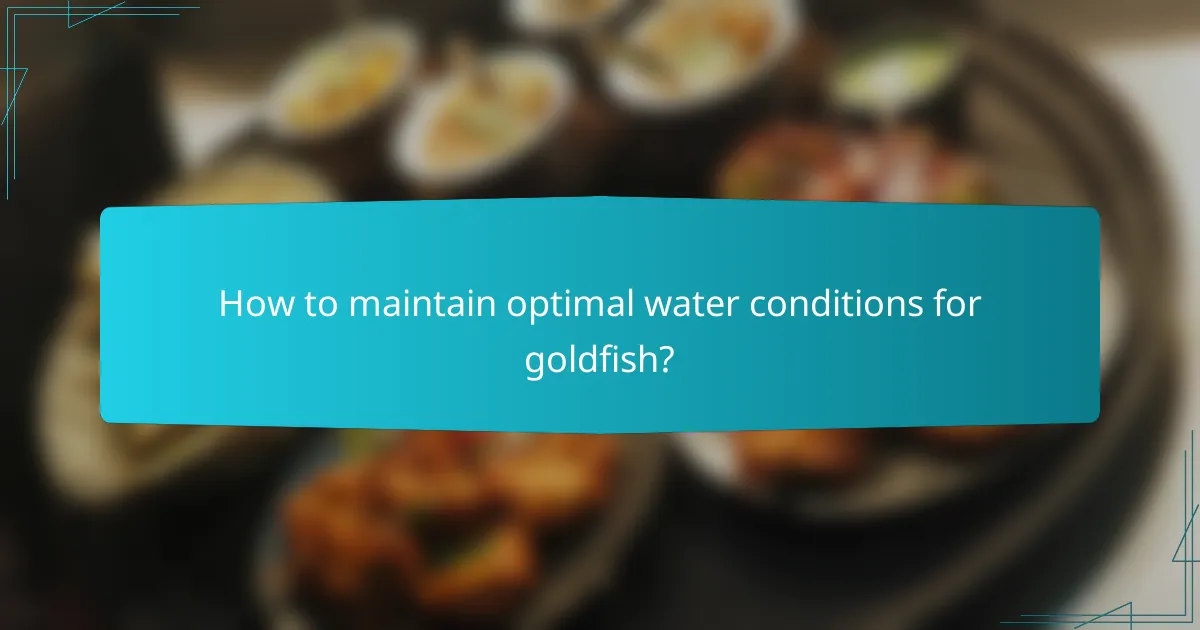
How to maintain optimal water conditions for goldfish?
Maintaining optimal water conditions for goldfish involves regular monitoring of water quality, including temperature, pH, and ammonia levels. Proper filtration and routine water changes are essential to ensure a healthy environment for your fish.
Importance of regular water testing
Regular water testing is crucial for identifying harmful substances like ammonia, nitrites, and nitrates that can affect goldfish health. Testing kits are widely available and can provide quick results, allowing you to take immediate action if levels are unsafe.
For goldfish, aim for ammonia and nitrite levels at 0 mg/L and nitrate levels below 40 mg/L. Testing weekly is recommended, especially in newly established tanks or after significant changes in the aquarium.
Recommended filtration systems
Choosing the right filtration system is vital for maintaining clean water conditions. A good filter should provide mechanical, biological, and chemical filtration to effectively remove debris and toxins.
Canister filters and hang-on-back filters are popular choices for goldfish tanks, as they offer strong water flow and ample filtration capacity. Ensure the filter is rated for at least double the tank volume to accommodate the waste produced by goldfish.

What are the best diets for goldfish to avoid health issues?
To prevent health issues in goldfish, it’s essential to provide a balanced diet that meets their nutritional needs. High-quality commercial foods and homemade options can both support their health and help avoid problems like swim bladder disease and ammonia poisoning.
High-quality commercial goldfish food
High-quality commercial goldfish food is specifically formulated to meet the dietary requirements of goldfish. Look for products that contain a balanced mix of proteins, fats, and vitamins, ensuring they are free from fillers and artificial additives.
When selecting commercial food, consider options that include ingredients like spirulina, krill, and other natural sources of nutrients. Feeding a varied diet, including pellets, flakes, and gel foods, can help maintain optimal health and prevent overfeeding.
Homemade diet options
Homemade diets can be a nutritious alternative for goldfish, but they require careful preparation to ensure they are balanced. Common ingredients include blanched vegetables like peas, spinach, and zucchini, as well as protein sources such as shrimp or fish.
When creating a homemade diet, aim for a mix of plant and protein-based foods, and avoid high-starch ingredients that can lead to swim bladder issues. It’s crucial to feed small amounts and monitor your goldfish’s response to prevent overfeeding and related health problems.

How does overfeeding affect goldfish behavior?
Overfeeding can significantly disrupt goldfish behavior, leading to stress and health issues. When goldfish consume more food than they can digest, it can result in a range of negative consequences, including behavioral changes and physical ailments.
Signs of stress from overfeeding
Goldfish may exhibit several signs of stress due to overfeeding, such as lethargy, hiding, or erratic swimming patterns. They might also show a lack of interest in food after an initial feeding frenzy, indicating discomfort.
Additionally, you may notice increased gill movement or abnormal buoyancy, which can signal that the fish is struggling to cope with the excess food in its system. Monitoring these signs is crucial for maintaining a healthy environment for your goldfish.
Behavioral changes due to excess food
Excess food can lead to significant behavioral changes in goldfish, such as aggression towards tank mates or increased territoriality. This is often a result of competition for resources, as the overabundance of food can create a stressful environment.
Moreover, goldfish may become less active and more prone to floating at the surface or sinking to the bottom. Regular feeding schedules and portion control are essential to prevent these negative behaviors and ensure a balanced diet for your fish.
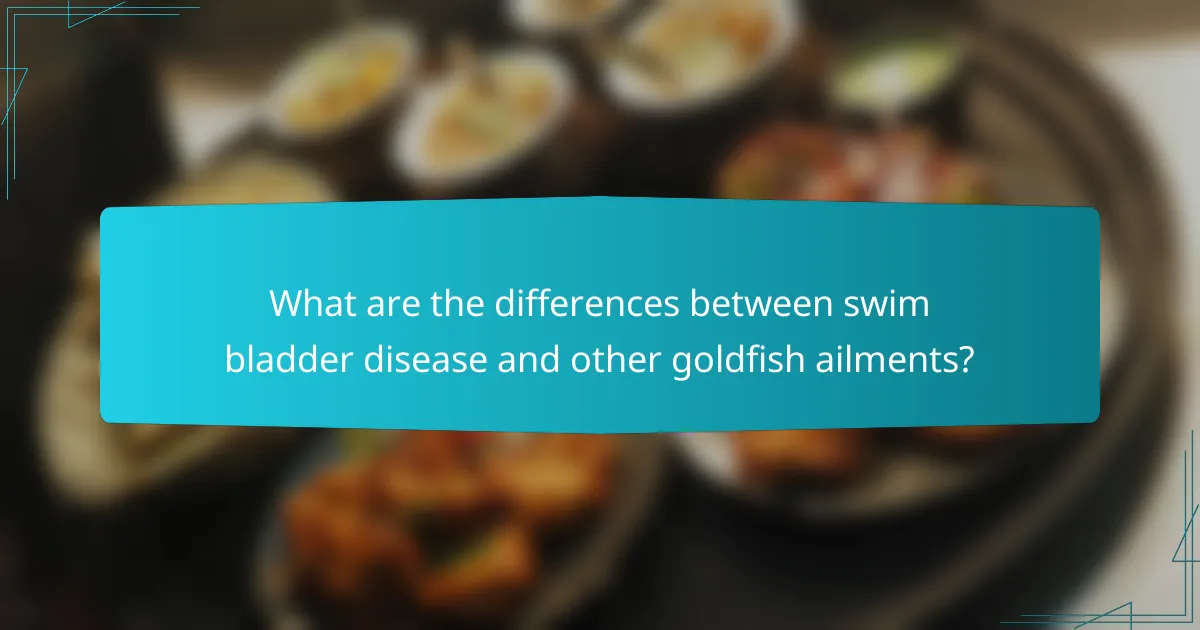
What are the differences between swim bladder disease and other goldfish ailments?
Swim bladder disease primarily affects a goldfish’s buoyancy, while other ailments like ammonia poisoning and overfeeding impact overall health and behavior. Understanding these differences is crucial for effective treatment and prevention.
Swim Bladder Disease
Swim bladder disease is a condition where the swim bladder, an organ that helps fish maintain buoyancy, becomes dysfunctional. Symptoms often include difficulty swimming, floating sideways, or sinking to the bottom. This ailment can arise from various factors, including genetic predisposition, infections, or environmental stressors.
To manage swim bladder disease, ensure your goldfish’s diet is appropriate and avoid overfeeding. A varied diet that includes high-quality pellets and occasional vegetables can help maintain digestive health, which is essential for swim bladder function.
Ammonia Poisoning
Ammonia poisoning occurs when ammonia levels in the water become toxic, often due to poor filtration or overstocking. Symptoms include lethargy, gasping at the surface, and abnormal swimming patterns. Regular water testing is vital to prevent ammonia buildup, as even low levels can be harmful over time.
To combat ammonia poisoning, perform regular water changes and ensure your aquarium has adequate filtration. Aim for ammonia levels to remain at 0 ppm, and monitor your goldfish closely for any signs of distress.
Overfeeding
Overfeeding is a common issue that can lead to obesity and water quality problems in goldfish. Symptoms include bloating, lethargy, and increased waste production, which can contribute to ammonia spikes in the tank. It’s essential to feed goldfish only what they can consume in a few minutes, typically once or twice a day.
To prevent overfeeding, establish a feeding schedule and use a measuring spoon for accuracy. Observing your goldfish’s behavior can also help; if they seem uninterested in food, it may be a sign to reduce portions.






